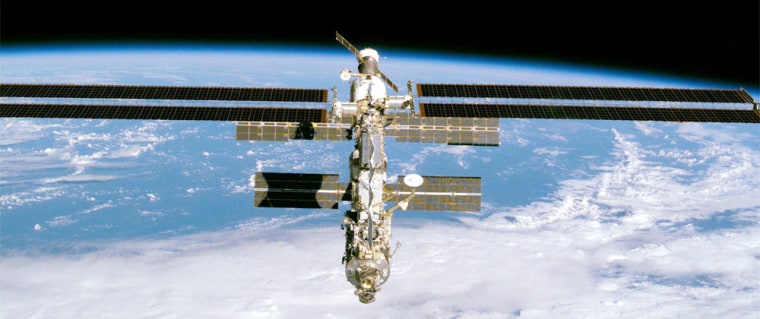NASA is seriously considering a Russian Space Agency request to extend the duration of the space station mission now planned for October from the current six months duration to a full year in space. Although several Russian cosmonauts have spent that much time or more in space, no American astronaut has ever gone beyond six and a half months in orbit.
The year-long space mission would in many ways mimic the medical challenges of an interplanetary human voyage. In January, President Bush announced a new "space vision" that called for redirecting space station research to exactly such challenges.
However, according to NASA memos obtained exclusively by MSNBC.com, the immediate motivation of this twelve month mission is money. In order to fund its cosmonaut program, Russia needs to commercially sell two seats aboard a Soyuz spacecraft flight now set for April 2005. But those seats would be unavailable if the station crew to be launched this October were to be rotated as currently planned after only six months in space.
Russia earns about $15 million for every extra ticket sold aboard the three-seat Soyuz. In the past, these seats have been sold to European astronauts and to private "space tourists."
NASA press officials did not return calls asking about this plan. However, another NASA expert told MSNBC.com, on condition of anonymity, "We're not crazy about the idea, but if the Russians go this way, we may not have much choice -- they are literally in the driver's seat."
Susan Creasy, the manager of the space station program’s “Operations and Utilization Office”, explained the challenge in a memo she circulated earlier this week. She explained that she had been telephoned by Aleksandr Derechin, a top official of the Energiya Rocket and Space Corporation (www.energia.ru), “to discuss Russian concerns with the upcoming manifests and increments. The Russian side is very interested in our working together to evaluate their proposal to be have the flexibility to extend Increment 10 [launched in October 2004] up to one year.”
The reason was money, since the year-long mission would “allow them to fully utilize the Spring [2005] Soyuz 10 for 2 taxi crewmembers.” Added Creasy, “the revenue from this is critical to their program.”
Derechin explained to Creasy that if the U.S. shuttle returns to flight in March 2005, as NASA currently plans, then the next crew can go up soon afterwards on a shuttle mission, and then there will be no need for a yearlong expedition of the men already in orbit. But in case of more shuttle delays, he wanted to prepare for the full-year option.
Meanwhile, the next crew station will go up in four weeks, on a Russian Soyuz, and they are still set to return to Earth in October as planned. Russian cosmonaut Gennadiy Padalka and American astronaut Mike Fincke will relieve the current crew of Michael Foale and Aleksandr Kaleri. Padalka and Fincke were only assigned to this mission in January, after medical and psychological compatibility problems grounded two earlier teams.
The crew currently planned for October launch is a Russian named Salizhan Sharipov and an American named Leroy Chiao. However, a NASA source tells MSNBC.com that Chiao has told his astronaut team leader he is NOT willing to spend a full year away from his new wife. If so, another crew needs to be found in the next few weeks.
